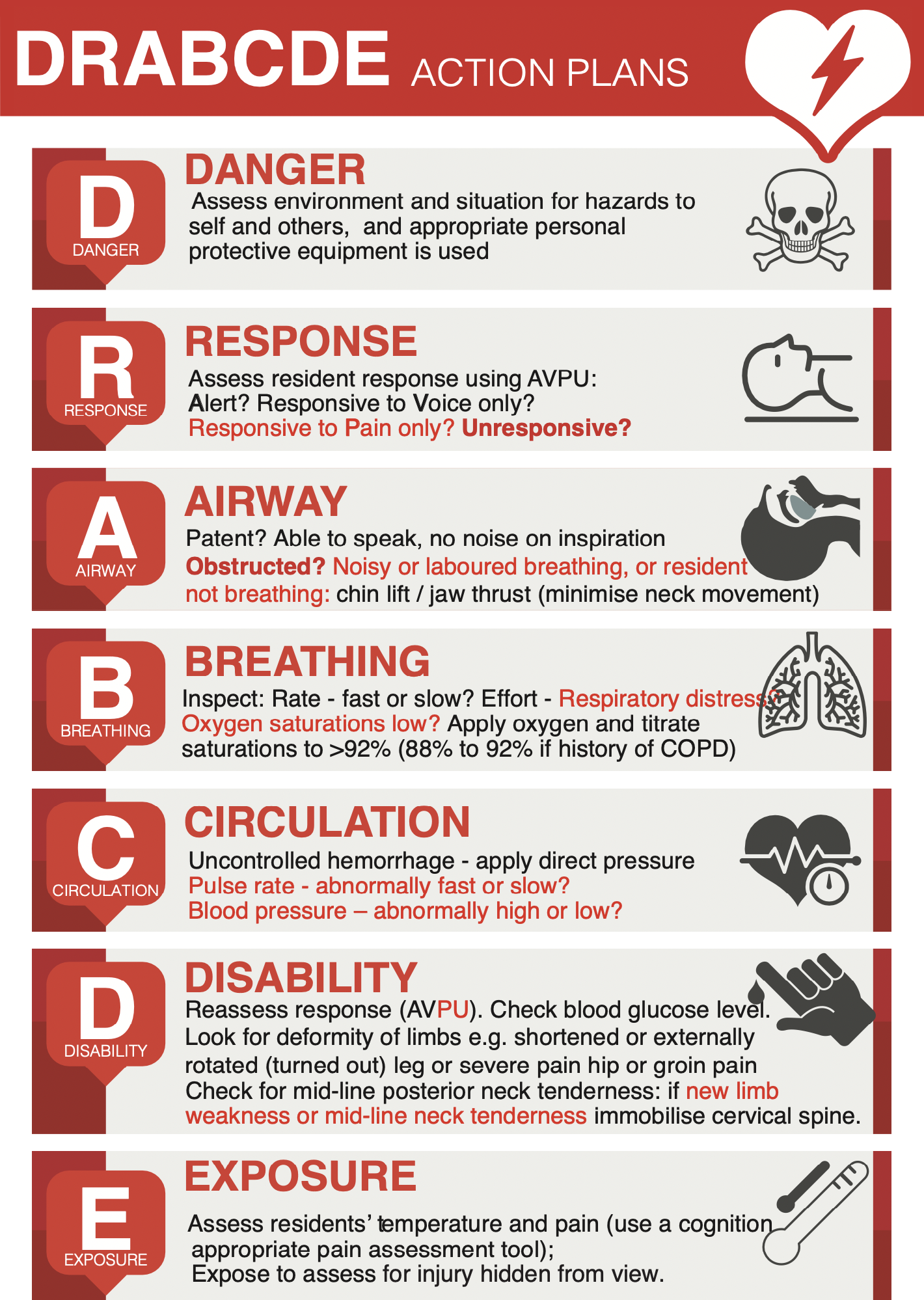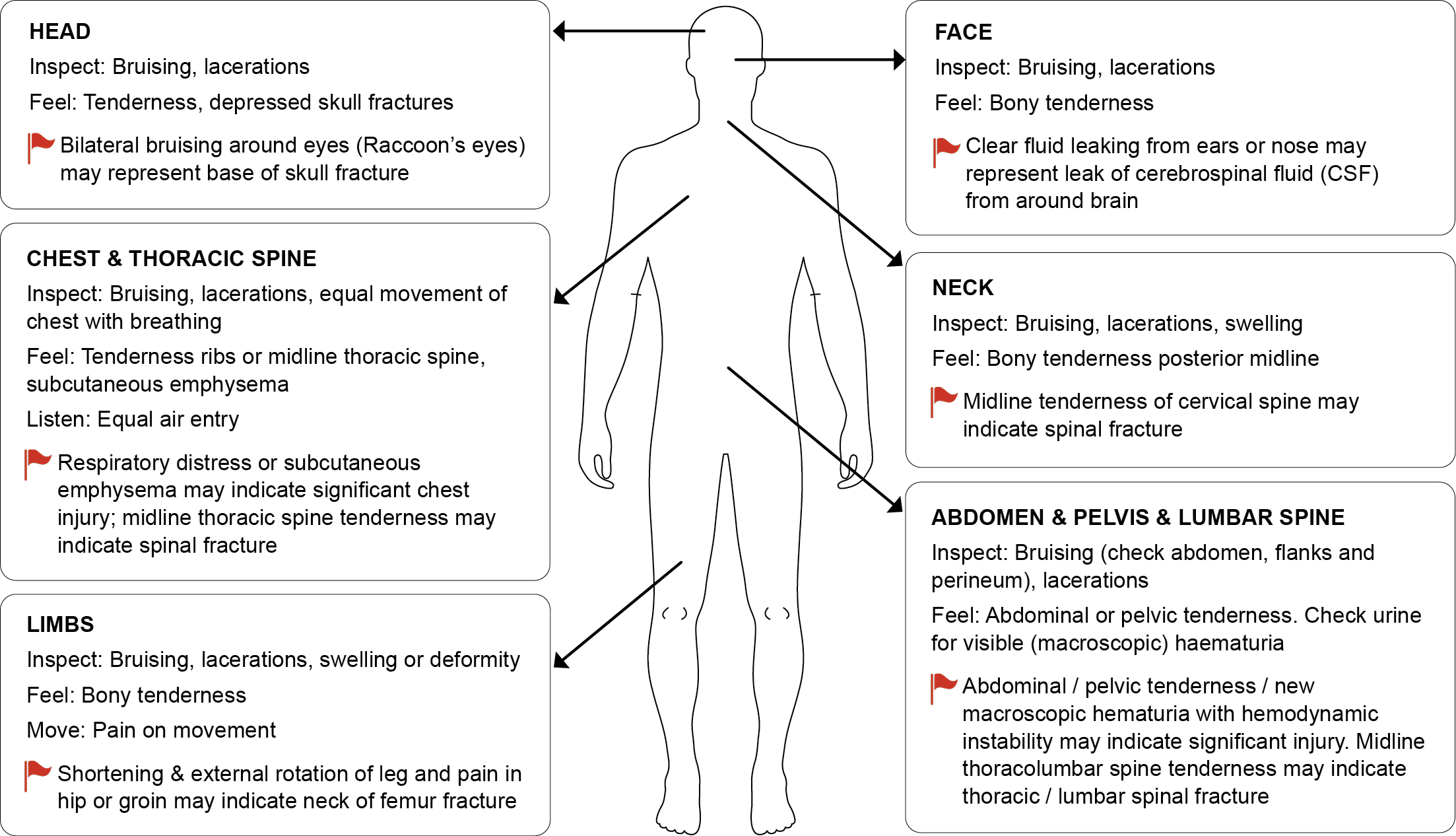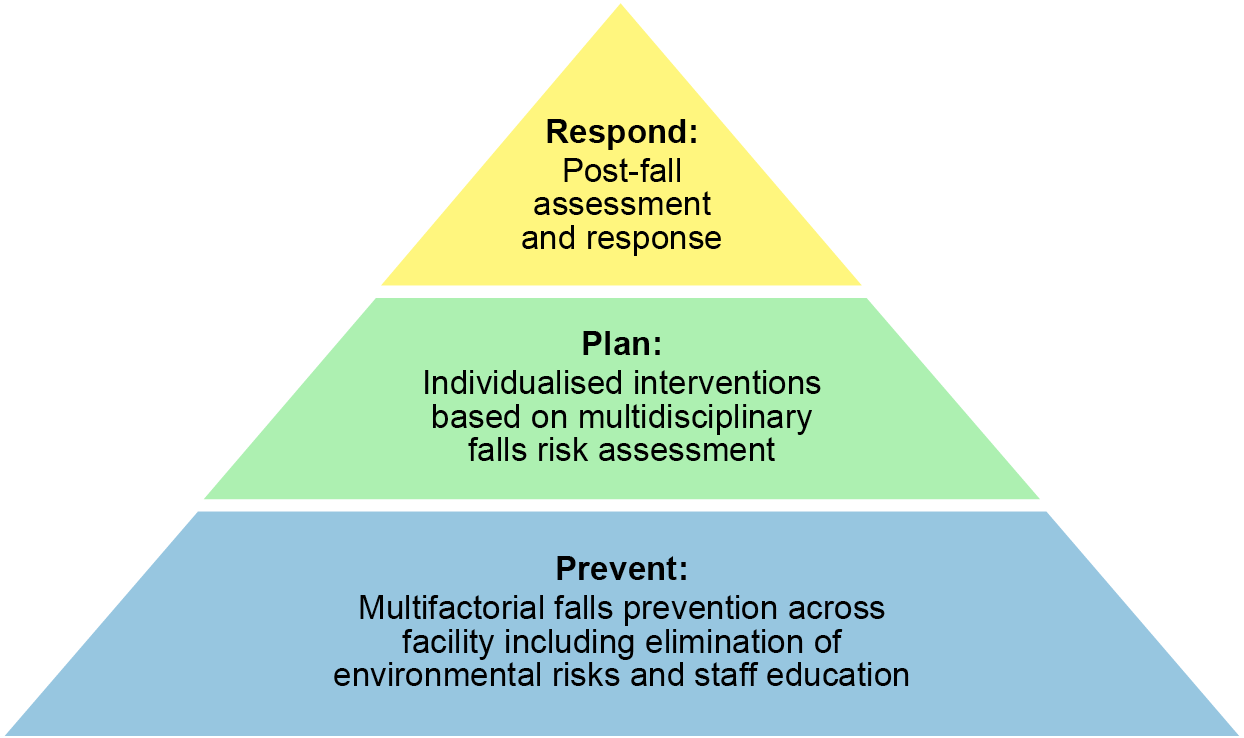Falls
This information does not replace clinical judgement. Refer to Conditions of use and copyright for further T&Cs.
Falls are associated with increased risk of morbidity and mortality in residents of Aged Care Facilities. All residents should be considered at high risk of falls and have a comprehensive multifactorial assessment at admission to identify factors contributing to falls risk and implement appropriate interventions to avoid falls and fall-related injuries.
Flowchart
The flowchart shows all of the information at one time. Health professionals should always remain within their scope of practice; these pathways should never replace clinical judgement.
Click the link below to view the full flowchart.
Practice points
The practice points are a systemised documentation of expanded relevant information - use only in conjunction with the flowchart - note, you can access each relevant point from the flowchart link.
-
A fall is defined by National Aged Care Mandatory Quality Indicator Program as “an event that results in a person coming to rest inadvertently on the ground or floor or other lower level.
E.g. A fall resulting in major injury is a fall that results in one or more of the following:
- Bone fractures.
- Joint dislocations.
- Closed head injury with altered consciousness and / or subdural haematoma”.
A fall may be identified or suspected through any of the following:
- Direct or indirect observation.
- Report of resident, bystander or falls detection technologies.
- Resident found on floor.
- Resident identified to have injuries suspected to be the result of a fall.
-
If a life-threat / red flag or unstable vital signs are identified on primary survey, refer to Management of residents with unstable vital signs pathway.
Primary survey entails the following assessments:
 Adapted with permission for use from TAFE Queensland
Adapted with permission for use from TAFE Queensland
-
Best practice in falls management of this predominantly frail cohort requires the clinician to balance:
- The clinical risks (actual from identified injury or underlying cause of the fall; and potential from risk assessment for deterioration) and,
- The risks of hospital transfer and associated iatrogenic injury and / or psychological trauma.
Policies of routine transfer to hospital of all residents after a fall are, in the absence of a specific clinical indication, not consistent with best practice. The 2022 World Guidelines for falls prevention and management for older adults recommend avoiding unnecessary transfer of residents to acute care.
Instead, such decisions should be individualised and informed by the clinical assessment, which should always be considered in the context of the individual’s life trajectory and in concordance with the expressed wishes of the resident (or where relevant, their substitute health decision maker). Routine transfer of residents to ED for CT head has potential negative impacts on residents.
Two recent Australian studies of ~ 1000 residents with falls found low rates of positive findings on CT head and no residents underwent neurosurgical intervention, even where there were positive CT head findings. Routine ED transfer and routine CT head in residents with falls and no clinical evidence of head injury is not supported by evidence. Transfers to hospital after a fall should be constrained to situations where the benefits of transfer for the resident exceed the risk and should occur in consultation with the resident and their nominated decision support person or substitute health decision maker.
-
The goals of assessment of a resident with a fall are to identify:
- Injuries resulting from the fall.
- Causes of the fall (intrinsic and extrinsic).
Obtain a history from the resident and any witnesses about the fall and any preceding symptoms or contributors.
A. Assessment for injuries related to the falls: A secondary survey is performed when immediate life-threats identified in primary survey have been addressed. Where red flags are identified, refer to Management of residents with unstable vital signs pathway.

B. Assessment for causes of the fall (intrinsic and extrinsic)
Falls in older persons are often the result of several predisposing factors placing residents at increased risk of falls and a precipitating factor, which may be intrinsic (related to an acute medical precipitant) or extrinsic (related to an environmental factor).
-
If any of the following red flags are identified in residents who have had a fall, review the resident’s advance care plan, consult resident (with nominated decision support person) or substitute health decision maker and refer to Management of residents with unstable vital signs pathway:
- Vital signs in the red or danger zone including new severe pain - refer to Recognition of the deteriorating resident
- New altered mental state (e.g. drop in Glasgow Coma Scale or difficult to rouse) relative to baseline
- New, painful bony deformity or hip pain with reduced range of motion or shortening / leg rotation (turned out) or a resident with a sudden change in their mobility post-fall
- Suspected head injury (witnessed head strike or any clinical signs head injury) in a resident with a known bleeding disorder or on anticoagulant or anti-platelet agent
- Major head trauma as indicated by any of:
- Signs of base of skull fracture (bruising around both eyes, cerebrospinal fluid / clear fluid leaking from ear or nose, bruising over mastoid process or bony prominence behind ear)
- Post-traumatic seizure
- New focal neurological deficit (e.g. limb weakness or paralysis or facial droop)
- Severe headache
- Persistent vomiting (2 or more vomits)
- Fall from > 1 metre
- Witnessed loss of consciousness
- Suspected spinal injury
- Uncontrolled bleeding or concern for concealed haemorrhage (e.g. unstable vital signs)
Note: A decision to transfer a resident to hospital after a fall should always consider resident goals of care and be respectful of informed choice by the resident (or substitute decision maker).
-
First screen for red flags as above - where red flags are identified in residents who have had a fall, review the resident’s advance care plan, consult resident (with nominated decision support person) or substitute health decision maker and refer to Management of residents with unstable vital signs pathway.
Escalate to HHS RaSS at GP discretion if any of (outside of HHS RaSS operational hours discuss with GP or after-hours GP service whether referral to ED or awaiting HHS RaSS opening hours is more appropriate in the individual resident’s context):
- Red flags in a resident who has conservative goals of care and does not wish to be transferred to hospital
- Resident with known bleeding disorder or on anticoagulant or anti-platelet therapy with either:
- Delay to GP ability to attend secondary survey or
- An unwitnessed fall with no clinical signs of head injury
- Wounds outside of scope of GP to manage independently of the hospital sector
- Suspected minor fracture
-
Each resident should have an individualised monitoring plan that considers life trajectory and goals of care and should be developed in consultation with the GP. In all residents, initial assessment should include a full set of vital signs including respiratory rate, oxygen saturation, heart rate, blood pressure, Glasgow Coma Scale (GCS), blood glucose level (BGL) and cognition-appropriate pain assessment.
Vital signs monitoring (Heart rate, blood pressure, respiratory rate, oxygen saturation, pain assessment) should then continue unless alternate medical orders provided:
- Hourly for 4 hours
- Then, if clinically stable, 2nd hourly for 6 hours, and if normal, 4th hourly until 24 hours post-injury
Neurological signs monitoring (conscious level, behaviour change, vomiting, pupils) is indicated where there is any one of the following: concern for a head injury (clinical signs of head injury or history of head strike) or unwitnessed fall in a cognitively impaired resident or where a resident is on anticoagulants or anti-platelet agents:
- Every 30 minutes for a minimum of 2 hours - escalate if remains below usual conscious level 2 hours after injury or if conscious level deteriorates at any time
- Then hourly for 4 hours, followed by 2-hourly for 4 hours and then 4-hourly for 40 hours
Note: If a resident is deteriorating on serial observations, escalate as per Management of residents with unstable vital signs pathway.
-
All residents should be considered at high risk of falls and have a comprehensive multifactorial assessment at admission to identify factors contributing to falls risk and implement appropriate interventions to avoid falls and fall-related injuries. This should be reviewed after each fall or with significant change in resident’s physical health and/ or mobility and/ or cognition, with adjustment of the intervention strategy for the resident.
There should be active consideration and proactive management of risk factors for falls including:
- Prevent falls through:
- Individualised exercise program, where appropriate, with emphasis on exercises that challenge balance and improve strength, e.g. Sunbeam Program of progressive resistance training and high challenge balance exercise
- Residential Medication Management Review (RMMR) to identify and review indication for medications that are sedating or that may contribute to postural hypotension; in residents with recurrent falls, GP to review indications for anti-platelet and anticoagulation medications to ensure benefit outweighs risk
- Ensuring well-fitted footwear - consider podiatry review
- Environmental review and modification
- Individualised continence program including regular toileting and, where indicated, continence aids
- Where indicated:
- Individualised mobility aid fitted with the assistance of physiotherapist
- Visual aids
- Dietitian review to address or prevent malnutrition and optimise calcium and protein intake
- Prevent injury through:
- Safe transfer techniques
- Hip protectors
- Vitamin D supplementation where levels are low or where residents are at risk of low vitamin D (minimal exposure to sunlight or malnourished)
- Osteoporosis management with vitamin D combined with calcium
- Protein supplementation
- Identify falls through:
- Fall alarm devices
- Visual observation
Figure 1: Preventing falls and harm from falls in aged care

- Prevent falls through:
References
-
- Australian Government Department of Health. National Aged Care Mandatory Quality Indicator Program. Manual 2.0 Part A. 2021. https://www.health.gov.au/sites/default/files/documents/2021/06/national-aged-caremandatory-
quality-indicator-program-manual-2-0-part-a-national-aged-care-mandatoryquality-indicator-program-manual-2-0-part-a-final-version.pdf accessed 12/09/2022. - Planas JH, Waseem M, Sigmon DF. Trauma Primary Survey. StatPearls. Treasure Island (FL)2022.
- Zemaitis MR, Planas JH, Waseem M. Trauma Secondary Survey. StatPearls. Treasure Island (FL)2022.
- Leung M. Approach to fall in an elderly patient. Journal of Medicine. 2021;19(26):1-8.
- Cameron ID, Dyer SM, Panagoda CE, Murray GR, Hill KD, Cumming RG, et al. Interventions for preventing falls in older people in care facilities and hospitals. Cochrane Database Syst Rev. 2018;9:CD005465.
- Peek K, Bryant J, Carey M, Dodd N, Freund M, Lawson S, et al. Reducing falls among people living with dementia: A systematic review. Dementia (London). 2020;19(5):1621-40.
- Wang F, Tian B. The effectiveness of physical exercise type and length to prevent falls in nursing homes: A systematic review and meta-analysis. J Clin Nurs. 2022;31(1-2):32-42.
- Hewitt J, Saing S, Goodall S, Henwood T, Clemson L, Refshauge K. An economic evaluation of the SUNBEAM programme: a falls-prevention randomized controlled trial in residential aged care. Clin Rehabil. 2019;33(3):524-34.
- Francis-Coad J, Etherton-Beer C, Burton E, Naseri C, Hill AM. Effectiveness of complex falls prevention interventions in residential aged care settings: a systematic review. JBI Database System Rev Implement Rep. 2018;16(4):973-1002.
- Zhang X, Dou Q, Zhang W, Wang C, Xie X, Yang Y, et al. Frailty as a predictor of all-cause mortality among older nursing home residents: a systematic review and meta-analysis. JAMDA. 2019;20:657-63.
- Pages PJ, Boncoeur-Martel MP, Dalmay F, Salle H, Caire F, Mounayer C, et al. Relevance of emergency head CT scan for fall in the elderly person. J Neuroradiol. 2020;47(1):54-8.
- Mori K, Abe T, Matsumoto J, Takahashi K, Takeuchi I. Indications for Computed Tomography in Older Adult Patients With Minor Head Injury in the Emergency Department. Acad Emerg Med. 2021;28(4):435-43.
- Lampart A, Kuster T, Nickel CH, Bingisser R, Pedersen V. Prevalence and Severity of Traumatic Intracranial Hemorrhage in Older Adults with Low-Energy Falls. J Am Geriatr Soc. 2020;68(5):977-82.
- Ganetsky M, Lopez G, Coreanu T, Novack V, Horng S, Shapiro NI, et al. Risk of
Intracranial Hemorrhage in Ground-level Fall With Antiplatelet or Anticoagulant Agents. Acad Emerg Med. 2017;24(10):1258-66. - Brown AJ, Witham MD, George J. Development of a risk score to guide brain imaging in older patients admitted with falls and confusion. Br J Radiol. 2011;84(1004):756-7.
- Easter JS, Haukoos JS, Meehan WP, Novack V, Edlow JA. Will Neuroimaging Reveal a Severe Intracranial Injury in This Adult With Minor Head Trauma?: The Rational Clinical Examination Systematic Review. JAMA. 2015;314(24):2672-81.
- Lee C, Beavers J, Pham J, Hackett L, Miller J, Buntine P. Impact of the Canadian CT head rule supplemented by the original published minimum inclusion criteria to assist emergency department clinicians' assessment of patients presenting post fall from residential aged care: a retrospective audit. BMC Geriatr. 2022;22(1):607.
- Green L, Selleck L, Gibbons M, Klim S, Ritchie P, Patel R, et al. Does the evidence justify routine transfer of residents of aged care facilities for CT scan after minor head trauma? Intern Med J. 2020;50(9):1048-52.
- Montero-Odasso M, van der Velde N, Martin FC, Petrovic M, Tan MP, Ryg J, et al. World guidelines for falls prevention and management for older adults: a global initiative. Age Ageing. 2022;51(9).
- Williams JG, Bachman MW, Lyons MD, Currie BB, Brown LH, Jones AW, et al. Improving Decisions About Transport to the Emergency Department for Assisted Living Residents Who Fall. Ann Intern Med. 2018;168(3):179-86.
- Gulka HJ, Patel V, Arora T, McArthur C, Iaboni A. Efficacy and Generalizability of Falls Prevention Interventions in Nursing Homes: A Systematic Review and Meta-analysis. J Am Med Dir Assoc. 2020;21(8):1024-35 e4.
- CADTH. 2019. Vitamin D Supplementation for the Prevention of Falls and Fractures in Residents of Long-Term Care Facilities: A review of clinical effectiveness, cost- effectiveness, and guidelines. Ottawa: Canadian Agency for Drugs and Technologies in Health.
- Lee SWH, Mak VSL, Tang YW. Pharmacist services in nursing homes: A systematic review and meta-analysis. Br J Clin Pharmacol. 2019;85(12):2668-88.
- Santesso N, Carrasco-Labra A, Brignardello-Petersen R. Hip protectors for preventing hip fractures in older people. Cochrane Database Syst Rev. 2014(3):CD001255.
- Aberg A, Lundin-Olsson L, Rosendahl E. Implementation of evidence-based prevention of falls in rehabilitation units: a staff's interactive approach. J Rehab Med. 2009; 41(13): 1034-40.
- Australian Government Department of Health. National Aged Care Mandatory Quality Indicator Program. Manual 2.0 Part A. 2021. https://www.health.gov.au/sites/default/files/documents/2021/06/national-aged-caremandatory-
-
Pathway Falls in aged care facility residents Document ID CEQ-HIU-FRAIL-Falls-00014 Version no. 2.0.0 Approval Date 19/08/2023 Executive sponsor Executive Director Healthcare Improvement Unit Author Improving the quality and choice of care setting for residents of aged care facilities with acute healthcare needs steering committee in collaboration with Queensland Surgical Advisory Committee Custodian Queensland Dementia, Ageing and Frailty Clinical Network Supersedes Falls v1.0.0 Applicable to Residential aged care facility registered nurses and General Practitioners in Queensland RACFs, serviced by a RACF acute care support service (RaSS) Document source Internal (QHEPS) and external Authorisation Executive Director, Healthcare Improvement Unit Keywords Falls, injurious falls Relevant standards Aged Care Quality Standards:
Standard 2: ongoing assessments and planning with consumers
Standard 3: personal care and clinical care
Standard 8: organisational governance